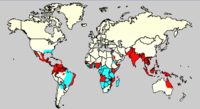
Photo from wikipedia
Background Arboviruses represent a threat to global public health. In the Americas, the dengue fever is endemic. This situation worsens with the introduction of emerging, Zika fever and chikungunya fever,… Click to show full abstract
Background Arboviruses represent a threat to global public health. In the Americas, the dengue fever is endemic. This situation worsens with the introduction of emerging, Zika fever and chikungunya fever, causing epidemics in several countries within the last decade. Hotspot analysis contributes to understanding the spatial and temporal dynamics in the context of co-circulation of these three arboviral diseases, which have the same vector: Aedes aegypti. Objective To analyze the spatial distribution and agreement between the hotspots of the historical series of reported dengue cases from 2000 to 2014 and the Zika, chikungunya and dengue cases hotspots from 2015 to 2019 in the city of Rio de Janeiro. Methods To identify hotspots, Gi* statistics were calculated for the annual incidence rates of reported cases of dengue, Zika, and chikungunya by neighborhood. Kendall’s W statistic was used to analyze the agreement between diseases hotspots. Results There was no agreement between the hotspots of the dengue fever historical series (2000–2014) and those of the emerging Zika fever and chikungunya fever (2015–2019). However, there was agreement between hotspots of the three arboviral diseases between 2015 and 2019. Conclusion The results of this study show the existence of persistent hotspots that need to be prioritized in public policies for the prevention and control of these diseases. The techniques used with data from epidemiological surveillance services can help in better understanding of the dynamics of these diseases wherever they circulate in the world.
Journal Title: PLoS ONE
Year Published: 2022
Link to full text (if available)
Share on Social Media: Sign Up to like & get
recommendations!